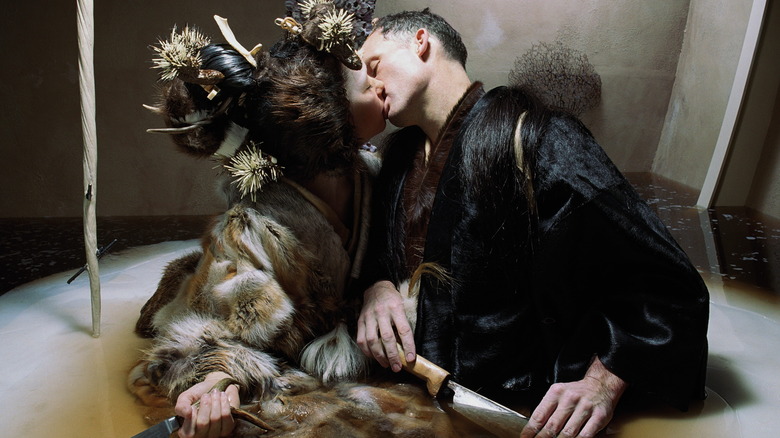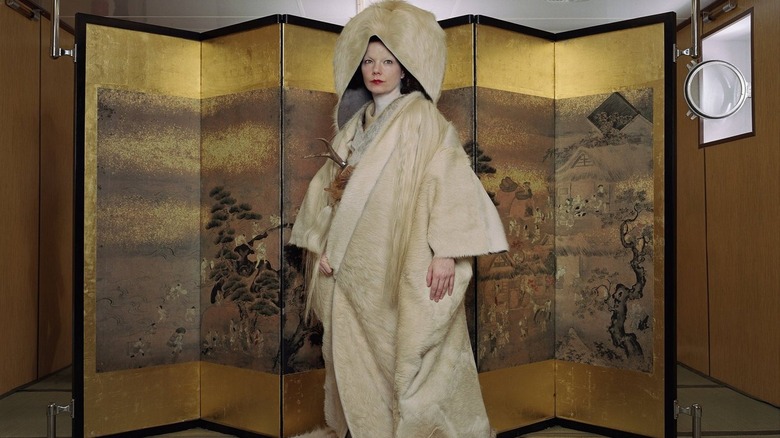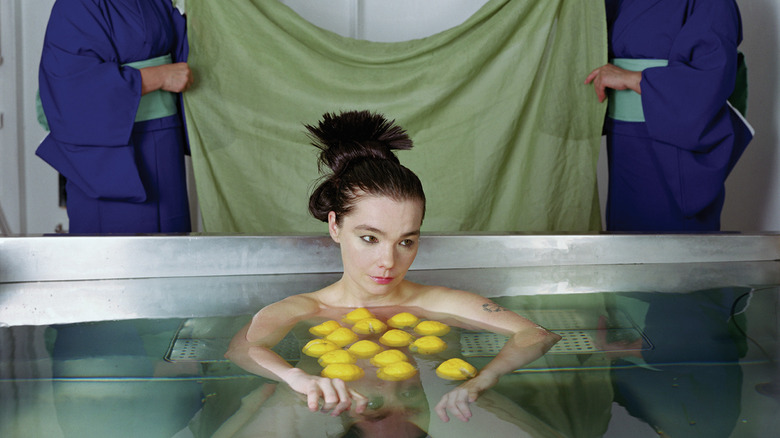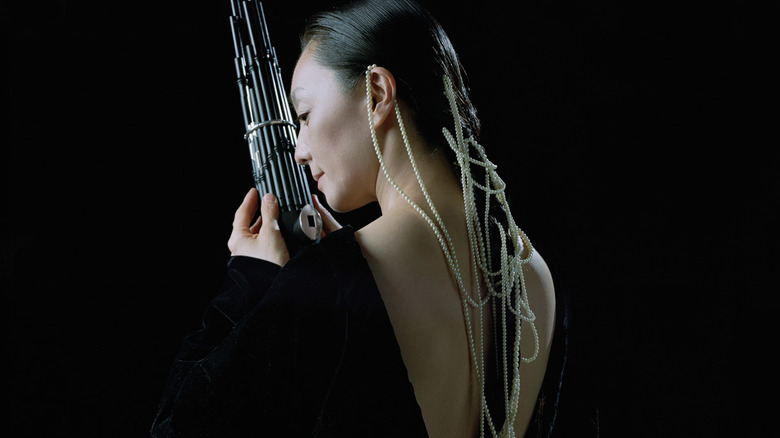The Bizarre Experimental Art Film Björk Made On A Japanese Whaling Vessel
Björk first caused a stir in the music world as the lead singer of The Sugarcubes, an left-of-the-dial, alterna-rock band that had its biggest hit in 1992 with the song "Hit." She achieved greater success as a solo artist, however, and her 1993 debut album, "Debut," came highly acclaimed. Björk's pop music is mercifully off-center, sometimes difficult, a bit quirky, and musically fascinating. Her albums are full-blown art projects, and sometimes center around a central theme. Her 2001 album, "Vespertine," is all about sex and sexuality, for instance. 2015's "Vulnicura" is about a bad breakup. Björk was also depicted as "kooky" in the press for the time she wore a gown that looked like a swan to the 73rd Academy Awards.
Björk was attending the 73rd Academy Awards because her song "I've Seen it All" from Lars von Trier's depressive musical "Dancer in the Dark" had been nominated. The controversial film about an impoverished machinist (Björk) who finds she is slowly losing her eyesight and is in a hurry to earn money to get an operation for her young son before he also begins going blind. Her character is betrayed by a co-worker, however, and her money is stolen, leading to an act of violence, a trial, and a strange and beatific devotion to keeping a promise, even if the promise is now meaningless. "Dancer in the Dark" is bleak, difficult, and nihilistic, and yet another film by von Trier wherein a female protagonist is emotionally tortured.
Björk had a horrid time filming and would eventually accuse von Trier of inappropriate sexual behavior, detailing his alleged crimes in a 2017 Facebook post. Von Trier denied the allegations and has said he and Björk were never friends. Despite the acclaim for her performance and music, making "Dancer in the Dark" was so miserable that Björk would not work on another feature film for five years. In 2005, Björk returned to the big screen in an oblique art installation made by her then-boyfriend, artist Matthew Barney. The film was "Drawing Restraint 9."
Matthew Barney's Drawing Restraint series
Matthew Barney is one of the more ambitious artists of his generation, frequently working iconography of Freemasons, Irish myth, building construction, and other evocative and mannered rituals to tell stories of artistic potential. He is perhaps best known in the film world for his five-film Cremaster Cycle, made out of order (4, 1, 5, 2, then 3) and all about the cremaster muscle, which controls the ascent or decent of the testicles. Barney used the muscle as a metaphor for artistic and gender potential, as the muscle is a factor in determining whether or not a fetus' gonads will ascend into ovaries or descend into testicles. "Cremaster 1" was the "female" end of the spectrum, and "Cremaster 5" was the "male." "Cremaster 3," a three-hour, dialogue-free surrealist epic about a Freemason ascending through the Chrysler Building, is all about the middle path, the genderless, the point where humans have the most potential.
The Cremaster Cycle, Barney has said, will never be made available on home video, as they were meant to be museum-only pieces. One can, however find a short film called "The Order" on the secondhand DVD market, which is a 35-minute portion of "Cremaster 3." Few films are as artistically and symbolically dense as "Cremaster 3," and it was one of the best films of 2003.
Prior to his work on the Cremaster Cycle, though, Barney was already engaged in a series of performance art pieces called Drawing Restraint. "Drawing Restraint 1" (1987) is currently on display at New York's Museum of Modern Art. It was made by Barney tethering himself in a harness and fighting to reach the canvas on the other side of the room. Other such restraining devices were used to achieve "Drawing Restraint 2" through "8" as well, which he continued to make through 2003. The physical struggle is a symbol, of course, for the restraints one must have (in Barney's estimation) in order to achieve great art.
Drawing Restraint 9
For "Drawing Restraint 9," though, Barney wanted to get more ambitious, and elected to make a feature film, very much in the spirit of his "Cremaster" movies. The restraint this time was an enormous, shield-shaped mold on the deck of a Japanese whaling vessel called the Nisshin Maru, which he would fill with 25 tons of molten petroleum jelly, allow to harden, and then remove the restraints to see if the gelatinous structure would hold. Barney would tie the project into a filmed, silent drama wherein a couple (Barney and Björk) would be married in a slightly aesthetic version of a Japanese marriage ritual, slice each other's legs with machetes, grow tails, and become whales.
"Drawing Restraint 9" takes a lot of iconography from Japanese culture, starting with the ship itself. The Nisshin Maru was one of the last whaling vessels in operation, whaling having been banned in most countries by 2005 (Iceland, incidentally, still allows the practice). Björk and Barney are clearly deeply in love — in that difficult-to-define way wherein artists become mutual muses — and used Shinto marriage rites and the rituals of ancient Japan as a codifying mechanism for their mutual affection. By 2005, Björk and Barney, while unmarried, were raising a child and living in New York.
"Drawing Restraint 9" is slow-moving, silent, and opaque, and yet it is never boring. Barney's ascetic imagery paired with Björk's atonal music made for a hypnotizing blend, and it was difficult not to be utterly in awe of the bizarre images presented. Barney is very good in visually capturing texture, and "Drawing Restraint 9" deals in the soft prickle of fur, the rough clatter of bone, the fleshy savor of severed muscle, the smoothness of pearls (pearl divers play an important role in the film). "Drawing Restraint 9" runs 135 minutes, but it feels simultaneously brief and lugubriously epic. It's rare that a film allows the eye to merely stare, slowly exploring an aesthetic space.
So what does it all mean?
"Drawing Restraint 9" is, like The Cremaster Cycle, not available on home video, but Björk did make a soundtrack record, which was widely distributed by One Little Indian Records (now One Little Independent Records). On the record, Björk collaborated with Mayumi Miyata playing the sho, a Japanese mouth organ. The soundtrack also included harp music by Zeena Parkins and celeste music by Jónas Sen, as well as sound effects, human panting, and instruments only professional musicians could identify. The lyrics to the soundtrack's opening track, "Gratitude," are an English translation of a letter written by an unknown Japanese citizen to General Douglas MacArthur for lifting the country's whaling ban in 1946.
An aspect of Matthew Barney's work that some find aggravating but others find rewarding is the amount of reading and research one needs to do to understand it. Barney likes to throw in references to creation myths, serial killers, classical music, medicine, and goodness knows what else, staunchly refusing to give the audience a skeleton key. He does, however, talk about his inspirations openly and will let you know he looked up Masonic initiation rites and Shinto marriage rituals he worked into his aesthetic.
I see, more than anything, two interesting artists who may not be welcoming an audience into their intimacy, but who are clearly in a deep emotional collaboration with each other. "Drawing Restraint 9" is strange, but it's certainly beautiful. Giving the limited release of "Drawing Restraint 9," it almost feels like a secret, like an art project Björk and Barney wanted to make for each other. It was his project, but "Drawing Restraint 9" breathes the air of Björk's music.
Still hurting from "Dancer in the Dark," however, Björk had effectively retired from acting after that. It would take Robert Eggers to bring Björk back to the big screen, and she can be seen playing her first role in 17 years in Eggers' Viking revenge story "The Northman." In the film, Björk plays a blind seer who guides the vengeance-inspired Viking hero. Björk, born in Reykjavík, was allowed to tap into her Icelandic roots for that film.
If she ever decides to make another film, it will be something to look forward to. One cannot fault her on making daring, interesting choices.



